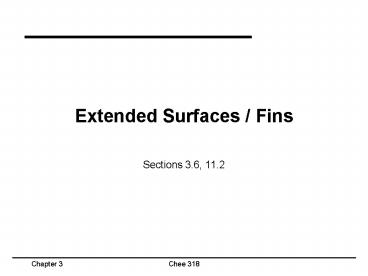Extended Surfaces Fins - PowerPoint PPT Presentation
1 / 18
Title:
Extended Surfaces Fins
Description:
Heat Transfer from ... Characterized by large heat transfer surface areas per unit ... resistance to convection heat transfer, by increasing surface area. ... – PowerPoint PPT presentation
Number of Views:4745
Avg rating:3.0/5.0
Title: Extended Surfaces Fins
1
Extended Surfaces / Fins
- Sections 3.6, 11.2
2
Extended Surfaces (Fins)
- An extended surface (also known as a combined
conduction-convection system or a fin) is a solid
within which heat transfer by conduction is
assumed to be one dimensional, while heat is also
transferred by convection (and/or radiation) from
the surface in a direction transverse to that of
conduction
36
3
Heat Transfer from Extended Surfaces
- Extended surfaces may exist in many situations
but are commonly used as fins to enhance heat
transfer by increasing the surface area available
for convection (and/or radiation).
37
4
Typical Fin Configurations
38
5
True or False?
- Heat is transferred from hot water flowing
through a tube to air flowing over the tube. To
enhance the heat transfer rate the fins should be
installed on the tube interior surface (the hot
water side) - Fins are particularly beneficial when h is small
(typical for a gas or when only natural
convection exists). - Ideally the fin material should have a large
thermal conductivity to minimize temperature
variations from its base to its tip.
6
Fins of Uniform Cross-Sectional Area
- Assuming one-dimensional, steady-state
conduction in an extended surface of constant
conductivity and uniform cross-sectional area
with negligible generation and radiation, the fin
equation is of the form
(3.6.1)
where p is the fin perimeter
Define
39
7
Boundary Conditions
Case A
- At the base T Tb or q(0)qb
- At the tip
- Case A Convection heat transfer
- Case B Adiabatic tip
- Case C Prescribed temperature, q(L)qL
- Case D Infinite fin, T(L)T? or q(L)0
40
8
Solutions of Differential Equation
(3.6.2)
41
9
Selection of fin material (Example 3.9)
(1)
SS
(2)
Al
kCugtkAlgtkSS
Cu
(3)
10
Example Problem 3.116
- Assessment of cooling scheme for gas turbine
blade. - Determine whether the blade temperature is less
than the maximum allowable value (1050 C) for
the prescribed operating conditions - Evaluate blade cooling rate.
- Assume that convective heat losses from the
surface are negligible, i.e. adiabatic tip
condition.
42
11
Fin Performance
- Fin effectiveness Ratio of the fin heat transfer
rate qf to the heat transfer rate that would
exist without the fin
where qbTb-T?, and Ac,b is the fin
cross-sectional area at the base
(3.6.3)
- ef should be as large as possible (at least gt2)
- For a very long (infinite) fin (Case D boundary
condition)
(3.6.4)
43
12
Fin Performance
- Fin heat transfer rate
where Rt,f is the fin resistance
- Can express fin effectiveness as a ratio of
thermal resistances
where Rt,b is the resistance due to convection
of the exposed base (1/hAc,b)
44
13
Fin Performance
- Fin efficiency The ratio of the actual heat
transfer rate from the fin to the maximum rate at
which a fin could dissipate energy
See Table 3.5 and Figures 3.18 and 3.19 for the
efficiencies of common fin shapes
(3.6.5)
- We can use the efficiency to calculate the fin
resistance
(3.6.6)
45
14
Fin Arrays
- Define the overall efficiency, ho as
(3.6.7)
where N is the number of fins in the array, Af
the surface area of each fin and At the total
surface area.
- We can then calculate the heat rate for the fin
array
(3.6.8)
- Thermal resistance of the fin array
(3.6.9)
46
15
Fin Manufacturing
- Care must be exercised to ensure that the
thermal contact resistance does not adversely
influence the overall fin performance
47
16
Example
- As more components are placed on a single
intergrated circuit (chip), the amount of heat
dissipated increases. The maximum allowable chip
operating temperature, is approximately 75C.
Suggest ways to maximize heat dissipation.
Air, T?20C
Side view
Top view
48
17
Fins in Heat Exchangers
- Widely used to achieve large heat rates per unit
volume, particularly when one or both fluids is a
gas. - Characterized by large heat transfer surface
areas per unit volume (gt700 m2/m3), small flow
passages, and laminar flow.
18
Fin (extended surface) effects
- Fins reduce the resistance to convection heat
transfer, by increasing surface area. - The expression for the overall heat transfer
coefficient includes overall surface efficiency,
or temperature efficiency, ho, of the finned
surface, which depends on the type of fin (see
also Ch. 3.6.5)
(11.5)
where c is for cold and h for hot fluids
respectively

